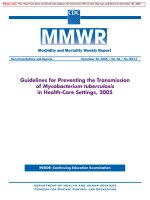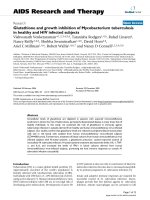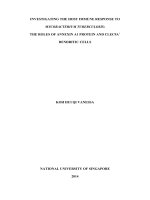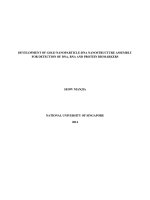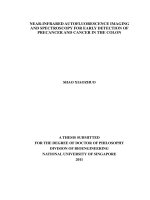Detection of Mycobacterium tuberculosis in dog of Assam
Bạn đang xem bản rút gọn của tài liệu. Xem và tải ngay bản đầy đủ của tài liệu tại đây (652.93 KB, 6 trang )
Int.J.Curr.Microbiol.App.Sci (2019) 8(5): 1283-1288
International Journal of Current Microbiology and Applied Sciences
ISSN: 2319-7706 Volume 8 Number 05 (2019)
Journal homepage:
Original Research Article
/>
Detection of Mycobacterium tuberculosis in Dog of Assam
Acheenta G. Barua1*, Koushik Kakoty1, Pranjal M. Nath1 and Bhaben Baishya2
1
Department of Veterinary Public Health, 2Teaching Veterinary Clinical Complex, College of
Veterinary Science, Assam Agricultural University, Khanapara, Guwahati-781022, India
*Corresponding author
ABSTRACT
Keywords
Dog,
Mycobacterium,
TST, IFN-γ assay
Article Info
Accepted:
12April 2019
Available Online:
10 May 2019
A total of 52 suspected dogs with symptoms of harsh, chronic non-productive coughing,
fever and anorexia were examined for tuberculosis in the Teaching Veterinary Clinical
Complex, Guwahati, Assam. SIT carried out by injecting 0.1ml of tuberculin (2TU, 5TU
and 10TU) at either the skin of the thorax at the level of the costochrondral junction or the
skin on the medial aspect of the hind limb in the thigh region and blood was collected
aseptically for IFN-γ assay. Out of which the 2 dogs were found positive for TST and 3
dogs were positive for IFN-gamma assay. Moreover, X‐ray was carried out in 4 suspected
dogs and only one dog had shown suspected lesion in the lung. Post-mortem was also
carried out in 3 suspected tuberculosis cases brought to the Teaching Veterinary Clinical
Complex (TVCC), Guwahati, Assam. An isolate of Mycobacterium was recovered from
the suspected lesion test and confirmed as Mycobacterium tuberculosis by biochemical test
and PCR assay. These parameters may be used for diagnosis of tuberculosis in dog.
Introduction
been highlighted by previous author (Snider
1971).
Natural
infection
by
Mycobacterium
tuberculosisis uncommonly isolated from
cases of animal tuberculosis following close,
prolonged contact with infectious humans
(Michel et al., 2003). Companion animals
living in contact with TB patients are at great
risk of exposure to this pathogen and post
mortem surveys performed in European cities
in the first half of the 20th century determined
the prevalence of canine TB as varying
between 0.1 and 6.7% (Snider, 1971). Also
the diseased companion animals can be the
potential source of infection to human has
Tuberculosis is one of India's major public
health problems. According to WHO
estimates, India has the world's largest
tuberculosis epidemic (WHO, 2006). In such
environments, epidemiological investigations
of both non-clinical M. tuberculosis infection
and clinical TB disease have evidenced high
levels of M. tuberculosis transmission
between people and it can be expected that
companion
animals
living
in
such
environments will be at particular risk of
infection by this pathogen. However, TB is
1283
Int.J.Curr.Microbiol.App.Sci (2019) 8(5): 1283-1288
prevalent in resource-poor settings in which
sophisticated veterinary services are generally
unavailable and where cases of canine TB
will remain largely undetected.
In addition to the lack of clinical data about
canine TB, a comprehensive understanding of
this disease is further limited by the absence
of practical immunological tests for the
diagnosis of both clinical disease and nonclinical M. tuberculosis infection in this
species. These tests typically rely on the
detection of antigen-specific T lymphocytemediated responses as surrogate markers of
infection by the causative organism (de la
Rua-Domenech et al., 2006). This principle is
employed in the in vivo tuberculin skin test
(TST) which characterises the inflammatory
response to mycobacterial purified protein
derivative (PPD). Similarly, the more recently
described interferon-gamma (IFN-c) release
assays (IGRA) quantify the in vitro release of
IFN-c by lymphocytes stimulated by M.
tuberculosis-specific antigens. Currently, no
standard protocols exist for the TST in
canines as it has long been believed that this
test is unreliable in dogs and that the use of
regular M. tuberculosis and M. bovis PPD as
TST stimuli are uninformative (Bonovska et
al., 2005).
The present study was undertaken for the
purpose to investigate the occurrence of M.
tuberculosis infection in dogs by TST, IFN‐γ
and PCR assay and to determine the risk of
transmission of M. tuberculosis from
infectious human TB patients to contact dogs.
Materials and Methods
Fifty two dogs with symptoms of harsh,
chronic non-productive coughing, fever and
anorexia were brought to the Teaching
Veterinary Clinical Complex, Guwahati,
considering as a referral centre for disease
diagnosis and treatment.
Single TST
Prior to the TST, dogs were sedated with
Thiopental Sodium (25 mg/kg, i/v) (Thiosol
1gm, Neon Laboratories Ltd., Mumbai,
India). The TST was done by 3 intradermal
injections of 0.1 ml of 2TU, 5TU and 10TU
of Tuberculin PPD (Arkray Healthcare Ltd.,
Gujrat, India) in the medial aspect of thigh.
Skin thicknesses were measured at both sites
before the intradermal injection and after 72
hrs. If the skin thickness is more than 5mm, it
is considered as positive (OIE).
IFN-γ assay
Blood samples were collected aseptically for
IFN-γ assay. It was performed according to
kit procedures (life technologies IFN-γ canine
ELISA kit). Samples were read at a
wavelength of 450 nm to calculate optical
density. A sample was considered as positive
when the difference between mean optical
density value of a negative control with mean
optical density value of sample is equal or
higher than 0.100.
Radiographic studies
Chest radiography was made of each animal
in the dorso-ventral and left recumbent
position to determined opaque image in lung
lobes, military lesion in the lungs and heart,
enlargement of the liver, spleen, hilar and
mesenteric lymph node.
Gross necropsy
Carcasses were inspected with the standard
procedure for any gross visible lesion
suspected of tuberculosis. Organs and tissue
samples were collected from all the carcasses
for further analysis. In this study, an animal
was considered positive on necropsy if 1 or
more lymph nodes or other tissues contained
focal or multifocal abscesses or granulomas.
1284
Int.J.Curr.Microbiol.App.Sci (2019) 8(5): 1283-1288
Mycobacterial
identification
culture
and
species
Fresh samples were macerated and
decontaminated using NALC and inoculated
on to Lowenstein Jensen (LJ) media. Briefly,
approximately 1g of tissue exhibiting gross
visible lesions was sliced and homogenized
and then subjected for decontamination.
The supernatant was discarded and the pellet
formed re-suspended in 300μl of phosphate
buffered saline (140mMNaCl, 26mM KCl,
10.0mM Na2HPO4 and 1.7mM KH2PO4).
Then the re-suspended pellets were inoculated
in duplicates onto LJ slants (one incorporating
glycerol and the other pyruvate). LJ slants
were incubated at 37oC and observed weekly
for eight weeks. Using a sterile 0.1 μl plastic
loop, the re-suspended pellets were spread
and fixed at 80oC (for 10 min) onto a labelled
slide. The slides were subjected for staining
with modified ZN stain.
Biochemical analysis were performed for
species identification of mycobacteria as per
standard protocol, such as Nitrate reduction
test
(Kubica
and
Wayne,
1984),
Pyrazinamidase test (Wayne, 1974) and
Niacin detection test (Gadre et al., 1995).
DNA was isolated from bacterial culture and
PCR was done targeting hsp65 gene
amplifying 441bp as per De Los Monteros et
al., (1998).
Results and Discussion
In the current study, we assayed dogs with
TST and IFN-γ and necropsy tissue samples
with lesions suggestive of mycobacterial
infection from post-mortem dog using ZN
microscopy and compared the results with
those of culture, biochemical tests and PCR.
A total of 52 suspected dogs were tested by
using the TST and IFN-γ assay and out of
which the 2 dogs were found positive for TST
(Fig. 1) and 3 dogs were positive for IFN-γ.
Although precise determination of sensitivity
and specificity of each of the PPD employed
is not possible, it would be appear that TST
results were inconsistent with those of the
IFN-γ. The IFN-γ assay is advantageous over
the TST because IFN-γ assay has been
designed to be highly specific by using welldefined antigens, and it allows for the
inclusion of positive and negative controls.
Together, these findings support those of
other studies which have found the TST
ineffective in dogs (Bonovska et al., 2005).
Fig.1 A) 0.1ml PPD (2, 5 and 10 TU) injected intradermally in the shaved area ofmedial aspect
of the hind limb in the thigh region. B) Positive results after 48hrs for 5 TU. (< 5 mm)
A
B
1285
Int.J.Curr.Microbiol.App.Sci (2019) 8(5): 1283-1288
Fig.2 Survey radiography of the thorax. A) Suspected lesion in the right lobe of lung (arrow) B)
Pleural effusion can been seen (SIT positive reactor)
A
B
Fig.3 Areas of liquifactive necrosis, on incision creamy white materials ooze out
1286
Int.J.Curr.Microbiol.App.Sci (2019) 8(5): 1283-1288
Fig.4 PCR assay of hsp65 gene for Mycobacterium tuberculosis complex; L: 100 bp ladder,
M1&M2: Isolates in duplicate, M3: Positive control and N: Negative control
L
M1 M2
M3 N
500bp
441bp
100bp
Moreover, X‐ray was carried out in 4
suspected animals to detect pleural and
pericardial
effusion,
ascites
and
hepatomegaly, diffuse radio‐opaque images in
lung lobes, diffuse visible masses in
abdominal organs, hilar and mesenteric
lymphadenopathy etc. However only one dog
had shown suspected lesion in the lung (Fig.
2).
between human and dog is not well
established,
pet
owner,
veterinarian,
physicians and public should be aware of the
potential transmission. However, culture and
molecular assay will be helpful in
understanding the dynamics of tuberculosis
between human and dog.
Post-mortem was also carried out in 3
suspected tuberculosis cases brought to the
Teaching Veterinary Clinical Complex
(TVCC), Guwahati, Assam. Out of which one
dog was showing liquifactive necrosis on
liver and the tissue sample was processed for
isolation of Acid-fast (ZN positively-stained)
tuberculus bacteria. The isolate was recovered
from the suspected lesion and confirmed as
M. tuberculosis by biochemical test viz.
Niacin production, nitrate reduction, urease
production and PCR assay (Fig. 3 & 4). These
results were well supported by Parsons et al.,
(2008). Though transmission of tuberculosis
Authors are thankful to Department of
Biotechnology for funding the “Molecular
Epidemiology of Canine Tuberculosis in
Assam,
neighboring
States
and
its
Containments” and Director of Research
(Veterinary) for necessary facilities to carry
out the research. Due acknowledgement is
also extended to the abattoir workers for
providing samples.
Acknowledgement
References
Bonovska, M., Tzvetkov, Y., Najdenski, H.
and Bachvarova, Y. 2005. PCR for
1287
Int.J.Curr.Microbiol.App.Sci (2019) 8(5): 1283-1288
detection of PCR for detection of
Mycobacterium
tuberculosis
in
experimentally infected dogs. Journal
of Veterinary Medicine. B, Infectious
Diseases and Veterinary Public Health,
52: 165–170.
de la Rua-Domenech, R., Goodchild, A.T.,
Vordermeier, H.M., Hewinson, R.G.,
Christiansen, K.H., Clifton-Hadley,
R.S., 2006. Ante mortem diagnosis of
tuberculosis in cattle: a review of the
tuberculin tests, c-interferon assay and
other ancillary diagnostic techniques.
Research in Veterinary Science 81,
190–210.
de los Monteros L.E.E., Galán, J.C.,
Montserrat Gutiérrez, Samper, S.,
Marín,
Carlos
Martín,
J.F.G.,
Domínguez, L., de Rafael, L., Baquero,
F., Enrique Gómez-Mampaso, E.G. and
Blázquez, J., 1998. Allele-specific PCR
method based on pncA and oxyR
sequences
for
distinguishing
Mycobacterium
bovis
from
Mycobacterium
tuberculosis:
intraspecific M. bovis pncA sequence
polymorphism. J. Clin. Microbiol., 36:
239–242.
Gadre, D. V., Mahajan, M., Singh, N. R.,
Agarwal, D. S. and Talwar, V. 1995.
Niacin test for mycobacteria: a
comparative study of two methods. Ind.
J. Tub., 42: 225-226.
Kubica, G. P and Wayne, L. G. 1984.Clinical
microbiology. In: The Mycobacteria, a
source book, Part A. Marul Dekker, Inc,
New York, Basel, pp. 156.
Michel, A.L., Venter, L., Espie, I.W. and
Coetzee, M.L. 2003. Mycobacterium
tuberculosis infections in eight species
at the National Zoological Gardens of
South Africa, 1991–2001. Journal of
Zoo and Wildlife Medicine, 34: 364–
370.
OIE terrestrial manual, Bovine tuberculosis,
Chapter 2.4.6, />international-standard-setting/terrestrialmanual/access-online.
Parsons, S.D.C., Gous, T.A., Warren, R.M.
and van Helden, P.D., 2008. Pulmonary
Mycobacterium tuberculosis (Beijing
strain) infection in a stray dog. Journal
of the South African Veterinary
Association, 79: 95–98.
Snider, W.R., 1971. Tuberculosis in canine
and feline populations. American
Review of Respiratory Disease, 104:
877–887.
Wayne, L. G. 1974. Simple pyrazinamidase
and urease test for routine identification
of Mycobacteris. Am. Rev. Resp. Dis.,
109: 147-51.
WHO. Global tuberculosis control. WHO
report.
WHO/HTM/TB/2006.362.
Geneva: World Health Organization,
2006.
How to cite this article:
Acheenta G. Barua, Koushik Kakoty, Pranjal M. Nath and Bhaben Baishya. 2019. Detection of
Mycobacterium tuberculosis in Dog of Assam. Int.J.Curr.Microbiol.App.Sci. 8(05): 1283-1288.
doi: />
1288
